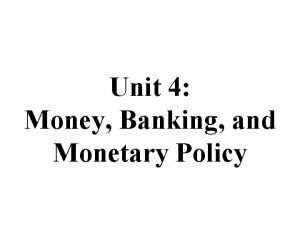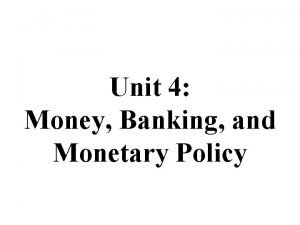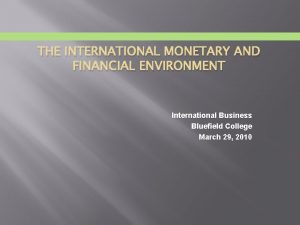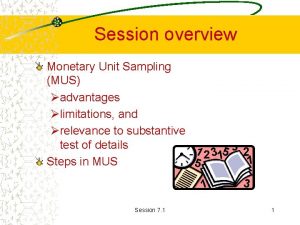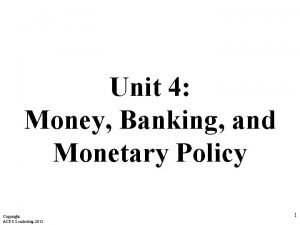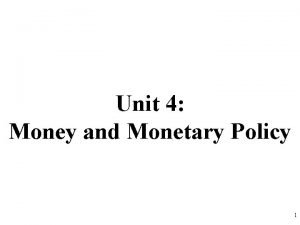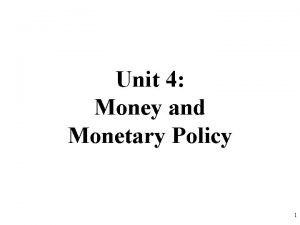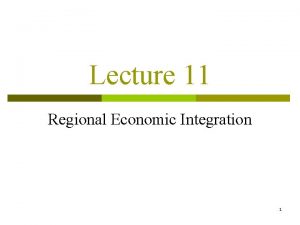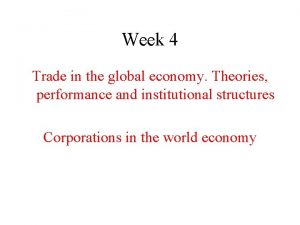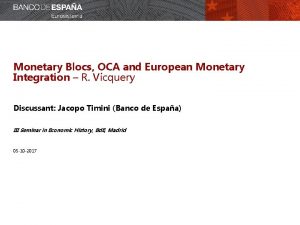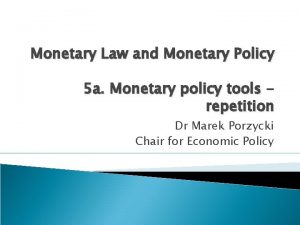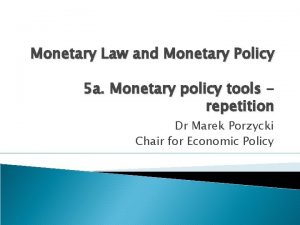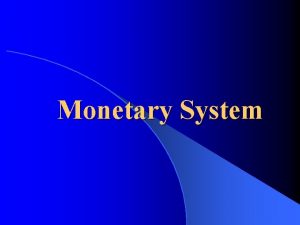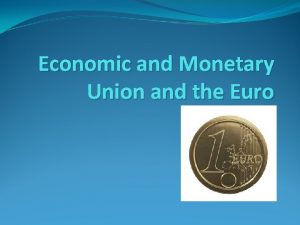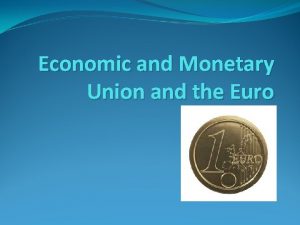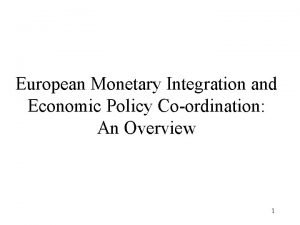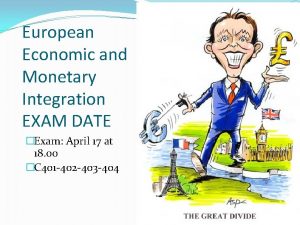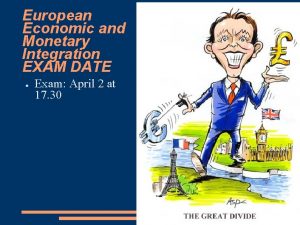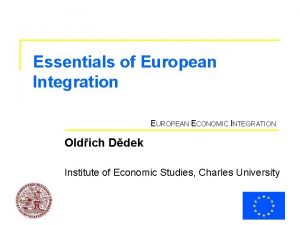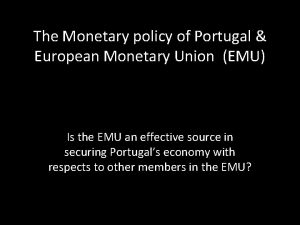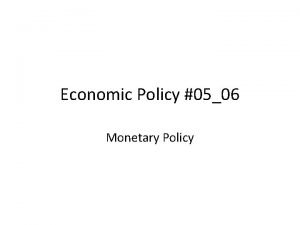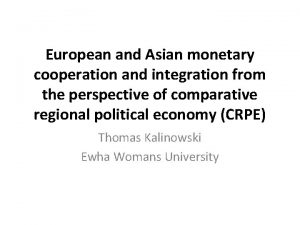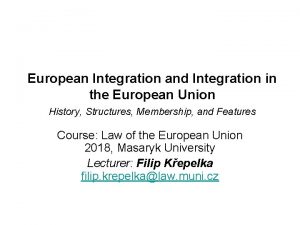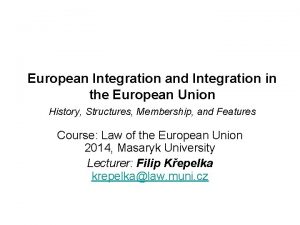Monetary Integration and the Euro EUROPEAN ECONOMIC INTEGRATION

















































- Slides: 49

Monetary Integration and the Euro EUROPEAN ECONOMIC INTEGRATION Oldřich Dědek Institute of Economic Studies, Charles University

Major themes in cost-benefit debate n Absorption of asymmetric shocks n Restoration of external price competitiveness n Autonomous monetary policy in face of growing capital mobility n Theory of optimum currency areas 2

Asymmetric shock – SD diagram P SF EF P SG EG DG DF Q France n n n Q Germany DF, DG … French, German demand curves (rising prices P discourage demanded quantity Q) SF, SG … French, German supply curves (rising prices P encourage supplied quantity Q) EF, EG … French, German market equilibrium 3

Asymmetric shock – primary adjustment P SF P SG E’G EF EG E'F D’F France n D’G DG DF Q Q Germany Autonomous demand shift from French to German goods q France: declining production, rising unemployment pressure for lower wages and lower inflation q Germany: rising production inflationary pressures 4

Asymmetric shock – use of exchange rate P SF P SG E’G EF EG E’F D’F France n DG DF Q Q Germany Devaluation of FRF and revaluation of DEM (fixed exchange rate) q q n D’G Cheaper French exports in Germany and more expensive German exports in France Rising demand for French goods and declining demand for German goods Return to initial equilibria prevailing before asymmetric shock 5

Asymmetric shock – absence of exchange S rate P F EF ED DF Q France n n n Primary effects (internal devaluation): drop in demand lower production and higher unemployment pressure on wages cheaper production output expansion (supply curve moves to south-east) Secondary effects: lower wages lower household expenditure contraction in output (demand curve moves to south-west) Danger of self-strengthening spiral of deflation and contraction 6

Asymmetric shock – secondary adjustment P S’F SF E’F EF DF D’F Q France n n n Devaluation increases prices of imports (including investment goods), higher production costs supply curve moves to left (new equilibrium EF’ removes part of positive effects of devaluation) Devaluation is accompanied by monetary tightening in order not to undo price pillow too fast Pass-through of devaluation is faster the more open the economy is 7

Asymmetric shock – vs. symmetric shock P SF EF France n n n SG EG D’F n P DG DF D’G Q Q Germany Symmetric shock hits all members of monetary union Danger of competitive devaluation (solving French problems at expense of Germany) Danger of retaliating competitive devaluations, which destabilise mutual trade and push up inflation only Difficult distinction between symmetric and asymmetric shocks in practice 8

Asymmetric shock – other practical considerations n Dubious circumstances for using the exchange rate as policy response q q q n Devaluation may weaken pressure for necessary restructuring (sleeping on the exchange rate pillow) Creation of tensions in other trading sectors (green rates in CAP) Permanent vs. transitory asymmetric shocks Outdated model of fixed but adjustable exchange rates q q Movements of floating exchange rate need not be linked to the occurrence of asymmetric shocks Overshooting in exchange rate changes 9

Competitiveness – purchasing power parity n n n Phillips curve postulates trade-off between inflation and unemployment (or growth rate) Different countries may have different preferences about inflation-unemployment mix (lower unemployment at cost of a higher inflation and vice versa) At different inflation rates, exchange rate helps restore price competitiveness q q Static PPP: PI = EI/G x PG Dynamic PPP: πI = e. I/G x πG 10

Competitiveness – equilibrium devaluation πI Italian PC German PC e. I/G πG u. I n n n u. G Existence of national currencies: devaluation of lira against mark restores price competitiveness of Italian exporters Absence of national currencies: national inflations must be equal (e. I/G = 0 πI = πG) Resulting inflation-unemployment mix need not be optimal in any country (too high unemployment in Italy and too high inflation in Germany) 11

Competitiveness – monetarist view n n n Market agents adjust prices and wages according to expected inflation monetary policy inefficiency in medium run (impossible to suppress unemployment below natural level) Only unexpected inflation (caused by unexpected devaluation) may have stimulating effects temporary effect due to adaptation of inflation expectations Phillips curve in medium run is vertical (no inflation-unemployment menus are available) 12

Competitiveness – vertical PC German PC (long-run) Italian PC (long-run) πI πG u. In n u. G n Creation of monetary union does not involve long-run costs (natural unemployment rate is not related to inflation) Higher-inflation country receives one-off bonus from importing low inflation (loss of exchange rate tool should not be seen as cost of monetary union) Problems can arise during adjustment to new equilibrium (termination of formal or informal indexation schemes) 13

Competitiveness – Barro-Gordon model n n Central bank announces its preferences about inflationunemployment trade-off through its decisions Market agents do not adjust behaviour to declared objectives if they are judged non-credible (suspicion of cheating) By entering monetary union, non-credible bank can no longer cheat about monetary policy, and inflation expectations are based on reputation of more credible central bank of monetary union Effect of borrowed credibility (recommendation to establish ECB on lines of Bundesbank) 14

Competitiveness – representation of BG model C πC πB πA Market judgement about CB indifference curves regarding inflation-unemployment mix Short-run Phillips curve Indifference curve of credible CB B A u. N n n n πA is non-credible inflation: agents do not believe that CB is honest about this inflation and do not adjust accordingly (CB is expected to use short-run PC to achieve preferred point B (market adjusts to expected inflation πB) πC is credible inflation: agents believe that CB is honest about this higher inflation (no cheating because PC cannot be used to attain higher indifference curve) Inflation πA can be achieved by entering monetary union with credible central bank 15

Monetary autonomy – Impossible Trinity n Impossible Trinity means that no monetary arrangement can reconcile simultaneously q q q Fixed exchange rates Autonomous monetary policy (in setting interest rates) Free capital movements n Uncovered interest rate parity n Practical examples q q Intrinsic instability of fixed but adjustable exchange rates (single currency solves the dilemma) Currency mismatches in foreign borrowing 16

Post-war monetary order n n Bretton-Woods arrangement as reaction to unprecedented inter-war instability (deep economic recession, protective practices, competitive devaluations) Pivotal role of US dollar (guarantor of store of value through link to gold, 1 oz = 35 $) Regime of fixed but adjustable exchange rates (fluctuations ± 1%) International Monetary Fund as overseer of world monetary order q q Extends loans to countries with temporary balance-ofpayments problems Monitors exchange rate realignments 17

European Payment Union (1950 -1958) n System for multilateral settlement of bilateral trade transactions q q n No direct debtor-creditor relationship among EPU members (only debtor-creditor positions vis-à-vis EPU) Makes for easier removal of bilateral trade restrictions EPU wound up after making member currencies convertible 18

Rome Treaty n n No explicit attention paid to potential creation of monetary union or fixed exchange rate arrangement Laid down some important prerequisites for eventual monetary union (full convertibility of currencies, abolition of capital controls, coordination of economic policies) No acute problem at time of well functioning of Bretton. Woods system Rising tensions in the end of 1960 s brought forward debate about benefits of stable currency (strong perception of advantages of single currency) q q q Devaluation of British pound in 1967(UK is not EEC member yet) Devaluation of French frank in 1967 (instability for CAP) Growing tensions of US dollar leading to the collapse of B-W system 19

Werner Report (1971) n n Ambitious plan proposing a three-stage move to monetary union starting in 1980 (irrevocably fixed exchange rates, eventual introduction of single currency) Clash of two approaches q q q n WR agenda shelved under pressure of acute economic problems q q q n Monetarist school: narrowing exchange rates fluctuations first that would promote deeper economic convergence (France, Belgium, Italy) Economist school: first economic coordination and convergence of economic performance and only then planning of monetary union (Germany, Netherlands) Compromise – convergence period of a fixed length Oil shock (1971) made visible different approaches to policy priorities Collapse of Bretton-Woods system (1973) Conspicuous divergence in inflations and unemployment rates European Monetary Cooperation Fund (EMCF) established in 1973 q Extension of short-term credits with the aim to stabilize balance of payments 20

Snake in the tunnel n Tunnel: European currencies fluctuate vis-à-vis US dollar in a range of ± 2¼ % around dollar central parities mutual fluctuations of up to 9 % ● ● DEM/USD +2¼ FRF/USD -2¼ ● ● n dollar parity Snake: European currencies fluctuate in a range of ± 2¼% around mutual bilateral central parities mutual fluctuations of up to 4½% FRF/DEM +2¼ bilateral parity -2¼ 21

Historical moments of monetary snake n n n n 24/4/72: Founding members Belgium, France, Italy, Luxemburg, Netherlands, West Germany 1/5/72: Denmark, United Kingdom enter 23/5/72: Norway associates 23/6/72: United Kingdom exits 27/6/72: Denmark exits 10/10/72: Denmark returns 13/2/73: Italy exits 19/3/73: Sweden associates 19/3/73: Collapse of Bretton-Woods system 3/4/73: Creation of European Monetary Cooperation Fund 19/1/74: France exits 10/7/74: France returns 15/3/76: France exits Source: Gros & Thygesen: European Monetary Integration. 22

European Monetary System (EMS) n n n EMS launched in March 1979 All EC members took part, but not in all components (integration à la carte) Major components of EMS q q European Currency Unit (ECU) Exchange Rate Mechanism (ERM) – voluntary membership European Monetary Cooperation Fund (system of credit facilities to defend fixed exchange rates) Divergence indicators 23

European Currency Unit – ECU n n Basket currency composed of given quantities of all EC currencies (not only those participating in ERM) Weights derived from economic strength of member countries (share in intra-EC trade, share in GDP) q q n n n Non-cash (scriptual) currency (no physical ECU banknotes and coins) Initial value set at 1 ECU = 1 USD Functions of ECU (official ECU) q q n Regular updates at 5 year intervals Maastricht Treaty locked the composition of ECU Unit for defining central rates in parity grid Accounting unit for EC budget Means of payment in official transactions (EC authorities, member states, international organisations) Political symbol (harbinger of possible monetary union) Private ECU q Financial market instruments denominated in ECU that tracked composition of ECU currency basket (deposits and loans, international bonds, foreign exchange contracts) 24

ECU – construction 25

ERM – parity grid n ERM as pegged but adjustable exchange rate system q q q n n Each ERM currency has its central parity vis-à-vis ECU Bilateral parities organised into matrix called parity grid Central parity as centre of fluctuation band with width ± 2¼% (Italy ± 6%) European nature (system functioning without any link to dollar or gold) – joint float vis-à-vis dollar Formal symmetry (absence of dominant currency) versus factual asymmetry (different pressures on debtor and creditor central banks during interventions) 26

ERM – illustration of parity grid 1 BEF = B BEF P 1 S DEM FRF ITL 1 DEM = 1 FRF = 100 ITL = 16, 03677 6, 91233 3, 62881 15, 68000 6, 75855 3, 41761 15, 33117 6, 60819 3, 21870 0, 44084 0, 23143 0, 43103 0, 21796 0, 42144 0, 20527 B 0, 06523 P 0, 06378 S 0, 06236 B 0, 15133 2, 37281 P 0, 14796 2, 32002 S 0, 14467 2, 26841 B 0, 31068 4, 87153 2, 09978 P 0, 29260 4, 58800 1, 97757 S 0, 27557 4, 32097 1, 86248 1 0, 53692 1 0, 50567 0, 47624 1 B … buying point, S … selling point, P … parity 27

ERM – operational features n Symmetric support q n Unlimited support q q n System of credit facilities urges central bank with strong currency to provide sufficient amounts of liquidity to central bank with weak currency Fixed deadlines for repayment of borrowed funds Collective realignments q n Central banks of both weak and strong currencies must take part in interventions Changes in parities based on agreement of all ERM members (protection against competitive devaluations) Divergence indicators q q Early warning indicators of exchange rate pressures with presumption to act (interest rate changes, budgetary measures, initiation of realignment, etc. ) Set at 75% distance of ± 2¼*×(1 -w) % from central parity (w is the weight of a given currency in ECU) 28

EMS stages – turbulent start (1979 -1985) n n Unstable international environment (following second oil shock) diverging inflations and policy responses ERM acted primarily as prevention against unilateral competitive devaluations q q n Frequent realignments (9 during 1 st stage) Large number of countries involved Systemic problems q q q Political tensions when big currencies were to be realigned (political cost of devaluation, opposition of business people against revaluation) High predictability of realignments waves of speculative activity Realignments caused by external events (weak dollar capital flows to Germany pressure on mark compulsory interventions) 29

EMS stages – German mark anchor (19861991) n Monetary leadership of Germany q q q n Illusion of approaching quasi monetary union q q n EMS members tended to coordinate interest rate changes with those of Germany (effect of borrowed credibility) Period of converging inflations and higher financial discipline No say of other countries in formulating German monetary policy In 1987 -1992 no realignments took place (except for techical ones) Apart from Greece all EC currencies became ERM members All currencies within narrow fluctuation band ± 2¼ % Other currencies pegged to ECU (Sweden, Finland) Plans to form EMU once again at top of agenda q q June 1988: Hanover European Council (EMU project launched) April 1989: Delors Report (plan to reach monetary union in 3 stages) December 1990: Intergovernmental conferences about EMU and political union December 1991: Agreement reached about Maastricht Treaty 30

Plan to reach EMU in three stages n Stage 1: from July 1990 to December 1993 q q q n Stage 2: from January 1994 to December 1998 q q q n Full liberalization of capital movements Closer coordination of monetary policies Fostering economic convergence Establishment of European Monetary Institute responsible for technical preparations for single currency Countries are fulfilling Maastricht convergence criteria (opt-out for UK and Denmark) Granting independence to national central banks Stage 3: from 1 st January 1999 onwards q q Irrevocably fixed exchange rates among participating countries ECB conducts single monetary policy ERM replaced by the successor regime ERM-II Stability and Growth Pact takes effect 31

EMS stages – currency crisis in 1992 -1993 n n Reunification of Germany sparked inflation pressures, high German rates criticised by other countries Less than perfect convergence accompanied by suspension of realignments perception of misaligned currencies (Italy, United Kingdom, Spain) Battered credibility of EMU (failed referendum about MT in Denmark, uncertainty about outcome in France) Consequences of crisis q q q British pound and Italian lira forced to withdraw from ERM at high costs Heavy speculation against currencies of Spain, Portugal, Denmark, Ireland, France August 1993: ERM fluctuation bands widened from ± 2¼ % to ± 15 % (wide bands not very different from floating) 32

EMS stages – heading towards euro (19941998) n Crisis in 1992 -1993 strengthened arguments of Impossible Trinity q n Promotion of exchange rate stability within wide bands q q n Choice among corner solutions: free floating versus single currency Lower risk of exchange rate speculation due to higher exchange rate uncertainty within wide bands Attacked currency moved back into narrow corridors Italy returned into ERM in 1997, UK and Sweden stayed permanently outside Austria and Finland entered ERM in 1995 after becoming members of EU Orderly transition to Stage 3 in spite of turbulences on global financial markets q q 1998: crisis in South-East Asia, Russian rouble crisis Those interested in EMU membership focused on fulfilling nominal convergence criteria remarkable improvement in public finances 33

Three phases of Stage 3 n Madrid Summit (December 1995) q q n Phase 1 (1999 -2001): circulation of euro in non-cash form q q n National currencies became non-decimal representations of euro Principle „no compulsion – no prohibition“ Phase 2 (Jan-June 2002): dual circulation q q q n Beginning of Stage 3: 1 January 1999 at latest ECU renamed euro Introduction of euro in physical form in coins and banknotes National currencies are withdrawing from circulation Logistically successfully managed changeover process Phase 3 q Euro is the only legal tender in Eurozone countries 34

Actual versus perceived inflation Source: European Commission 35

Explanation of perceived inflation n n n Consumers attach a higher importance to price developments of goods and services that they buy more frequently (out-of-the-pocket expenditures) Consumers are more influenced by upward price movements than by downward changes Consumers pay high attention to exceptional price increases despite a low weight of respective goods and services in consumer basket Prices in national currencies that ceased to exist remained reference units for comparisons with euro prices that were exposed to accumulated year-to-year inflation Problem of granulated currency (ITL, GRD): dismissive attitude toward national coins without purchasing power was transferred to euro coins with some purchasing power Public failed to differentiate between different reasons for higher inflation Accusation for price increases were amplified by media coverage (preference for bad news) 36

Maastricht convergence criteria n n n Creation of monetary union perceived as “coronation” of convergence process towards price stability Binding deadlines for start of Eurozone, not later than 1 January 1999 even with smaller group of countries Limited inspiration by OCA principles when qualification criteria were formulated; stress on operability and intelligibility 37

Convergence criteria – inflation n Maximum admissible limit: average of three lowest inflations in EU countries plus 1. 5 percentage points Indicator: Twelve month average HICP (Harmonised Index of Consumer Prices) Motivation q q q n Substantial inflation differentials make single monetary policy difficult to operate Erosion of price competitiveness without recourse to realignments “Value of price stability” adhered to by all Eurozone members (guarantee for Germany) Objections q q q Why inflation in countries outside Eurozone? Who are outliers (countries with extremely low inflation)? Too restrictive for catching-up countries (Balassa-Samuelson effect)? 38

Convergence criteria – long-term interest rates n Maximum admissible limit: average of interest rates in n n three EU countries with lowest inflation plus 2 percentage points Indicator: Average monthly yield on 10 -year government bonds Motivation q q n Sustainability test of low inflation and healthy public finances in longer term Avoiding large instability in pricing debt securities when they are converted from national currency to euro Objections q q Elimination of exchange rate risk in monetary union triggers convergence of bond yields (consequence of uncovered interest rate parity) Caveat: elimination of exchange rate risk does not eliminate credit risk 39

Convergence of long-term interest rates Source: Eurostat. n 40

Convergence criteria – exchange rate n n Content: Membership for at least two years in ERM II, keeping exchange rate within normal bands without severe tensions and devaluation of central parity Motivation q q n Objections q q q n Test of appropriateness of central parity before it is irrevocably fixed (ERM II as a training field) Preventing competitive devaluations prior to fixing (conversion rate should be close to market exchange rate) Outdated concept of a normal band (former narrow bands ± 2¼ % were abolished during 1992 -93 crisis) ERM II as a compulsory waiting room Exchange rate stability assessed from the perspective of more criteria Properties of ERM II q q Central rates are defined bilaterally in terms of euro Fluctuation margins ± 15 %, narrower margins can be negotiated with ECB or set unilaterally Automatic interventions on the margin provided they do not jeopardize price stability in Euro Area Exchange rate regimes incompatible with ERM II membership: free or managed float, unilateral euroization, exchange rate pegged to other currencies than euro 41

Convergence criteria – fiscal stance n Government deficit q q q n Deficit-to-GDP ratio shall not exceed the reference value of 3%, unless The ratio is steadily declining and approaching the reference value Exceeding the reference value is modest, exceptional and temporary Government debt q q q Debt-to-GDP ratio shall not exceed the reference value of 60%, unless The ratio is declining and approaching the reference value in satisfactory way Exceptions vital for Belgium, Italy and Greece 42

Links between debt and deficit (size of deficit ≈ change in debt) dt … ratio of deficit to GDP bt … ratio of debt to GDP gt … growth rate of nominal GDP 3% deficit and 60% debt are roughly consistent with 5% nominal GDP growth (approx. 2% inflation and 3% real GDP growth) 43

Theory of optimum currency areas (OCA) n n OCA is theoretical basis of whether countries should form monetary union = one authority responsible for conduct of monetary policy The author of OCA theory is Robert Mundell (Nobel prize winner in 1999) q n Other contributors: Peter Kenen, Ronald Mc. Kinnon, Jacob Frenkel OCA criteria (ability to adjust smoothly to asymmetric shocks): q q q Flexible labour markets (avoids painful drop in real wages in reaction to asymmetric shocks) Structural similarity (makes occurrence of asymmetric shocks less likely) Trade openness (diminishes efficiency of exchange rate adjustment) 44

Endogenous OCA n Endogenity principle q q n Elimination of exchange rate risk boosts mutual trade q q n Creation and maintenance of monetary union among countries which do not form OCA accelerates integration processes and contributes to achieving OCA faster Countries may form a monetary union even though they do not form optimum currency area Exchange rate stability improves efficiency of investment decisions Costly hedging with financial instruments (lack of long-term contracts) Absence of exchange rate risk leads to deeper integration q q q Price transparency enhances competition in product markets (complications due to price regulation, different tax system, consumer preferences) Easier capital mobility contributes to easier overcoming of asymmetric shocks Asymmetric shocks are made more symmetric (through more diversified ownership of assets) 45

Surveillance over macro-economic imbalances n Preventive arm q q q n Corrective arm q q q n Alert mechanism: a set of early warning indicators with thresholds arranged in the scoreboard whose aim is to detect MS with potential harmful imbalances In-depth review: detailed analyses focused on MS economies in which alert mechanism detected potential harmful imbalances Possible actions: 1. No problem, 2. Imbalances exist but are not severe, 3. Severe imbalances MS is placed in Excessive Imbalance Procedure Applied to Eurozone members only MS prepares Corrective Action Plan (fine 0. 1 % GDP if the plan is found insufficient) Surveillance of Plan‘s commitments (interest-bearing deposit 0. 1 % GDP if found insufficient, eventually converted into fine) Reverse qualified majority voting 46

Self-fulfilling prophecy n Vicious circle of debt trap q q n High debt (generated by public or private sector) concerns of bondholders are reflected in higher risk premiums strains in financial markets urge for fiscal consolidation higher taxes and expenditure cuts undermine growth prospects further concerns of investors about ability to repay the debt further escalation of risk premiums All consolidation efforts are consumed by excessive interest rates high incentive to declare bankruptcy despite extreme social costs Adjustment programme q q External official assistance gets rid of dependence on extremely costly borrowing from financial markets Conditionalities attached to the financial assistance should encourage reforms putting the government debt on sustainable path which is prerequisite to restoring the market confidence Painful therapy but there is no other user-friendly medicine Key role of debt sustainability analysis n b …. . debt-to-GDP ratio i. …. average interest rate paid on government debt g …. . growth rate of nominal GDP pb … primary budget balance (actual balance net of interest payments) k …. . stock-flow adjustment (impact of exchange rate changes, debt relief, privatization revenues, etc. ) 47

European stability mechanism n Principle of functioning n. Country n. MS n budgets Assis tance Capital Bonds n. ESM Capital market Funds Basic facts q q ESM was inaugurated in October 2012 as an international institution owned by Eurozone members Subscribed capital 700 bn EUR = paid capital (80) + callable capital (620) Net lending capacity 500 bn EUR (sufficient for obtaining highest rating for ESM bonds) Instruments: government loans, interventions on primary and secondary markets for government bonds, direct recapitalization of banks, fiscal backstop in Single Resolution Mechanism 48

Multi-speed Europe n Eurozone members q q n EU members and Eurozone non-members with permanent exception (opt-out) q q n ERM-II members: Denmark ERM-II non-members: United Kingdom EU members and Eurozone non-members with temporary exception (derogation) q q n Founders: Austria, Belgium, Finland, France, Germany, Ireland, Italy, Netherlands, Luxembourg, Portugal, Spain Enlargements: Greece (2001), Slovenia (2007), Cyprus and Malta (2008), Slovakia (2009), Estonia (2011), Latvia (2014), Lithuania (2015) ERM-II members: none ERM-II non-members: Sweden (euro rejected in referendum), Czech Republic, Hungary, Poland, Bulgaria, Rumania, Croatia European countries outside EU using euro as national currency q q National euro coins: Andorra, Monaco, San Marino, Vatican City Others: Kosovo, Monte Negro 49
 What is economic growth and development
What is economic growth and development European exploration economic reasons
European exploration economic reasons Economic growth vs economic development
Economic growth vs economic development Chapter 1 lesson 2 our economic choices worksheet answers
Chapter 1 lesson 2 our economic choices worksheet answers Unit 4 money banking and monetary policy
Unit 4 money banking and monetary policy Unit 4 money banking and monetary policy
Unit 4 money banking and monetary policy Unit 5 macroeconomics lesson 2 activity 45
Unit 5 macroeconomics lesson 2 activity 45 International monetary and financial environment
International monetary and financial environment International financial environment
International financial environment Monetary unit sample
Monetary unit sample Unit 4 money and monetary policy
Unit 4 money and monetary policy Unit 4 money and monetary policy
Unit 4 money and monetary policy Unit 4 money and monetary policy
Unit 4 money and monetary policy Three dimensions of corporate strategy
Three dimensions of corporate strategy Forward integration and backward integration
Forward integration and backward integration Example of simultaneous integration
Example of simultaneous integration Different types of economic integration
Different types of economic integration Regionalization and globalization venn diagram
Regionalization and globalization venn diagram William and mary ap euro
William and mary ap euro William and mary ap euro
William and mary ap euro Hình ảnh bộ gõ cơ thể búng tay
Hình ảnh bộ gõ cơ thể búng tay Slidetodoc
Slidetodoc Bổ thể
Bổ thể Tỉ lệ cơ thể trẻ em
Tỉ lệ cơ thể trẻ em Gấu đi như thế nào
Gấu đi như thế nào Tư thế worm breton là gì
Tư thế worm breton là gì Hát lên người ơi
Hát lên người ơi Các môn thể thao bắt đầu bằng tiếng bóng
Các môn thể thao bắt đầu bằng tiếng bóng Thế nào là hệ số cao nhất
Thế nào là hệ số cao nhất Các châu lục và đại dương trên thế giới
Các châu lục và đại dương trên thế giới Công thức tính độ biến thiên đông lượng
Công thức tính độ biến thiên đông lượng Trời xanh đây là của chúng ta thể thơ
Trời xanh đây là của chúng ta thể thơ Mật thư tọa độ 5x5
Mật thư tọa độ 5x5 Làm thế nào để 102-1=99
Làm thế nào để 102-1=99 Phản ứng thế ankan
Phản ứng thế ankan Các châu lục và đại dương trên thế giới
Các châu lục và đại dương trên thế giới Thơ thất ngôn tứ tuyệt đường luật
Thơ thất ngôn tứ tuyệt đường luật Quá trình desamine hóa có thể tạo ra
Quá trình desamine hóa có thể tạo ra Một số thể thơ truyền thống
Một số thể thơ truyền thống Cái miệng xinh xinh thế chỉ nói điều hay thôi
Cái miệng xinh xinh thế chỉ nói điều hay thôi Vẽ hình chiếu vuông góc của vật thể sau
Vẽ hình chiếu vuông góc của vật thể sau Thế nào là sự mỏi cơ
Thế nào là sự mỏi cơ đặc điểm cơ thể của người tối cổ
đặc điểm cơ thể của người tối cổ V. c c
V. c c Vẽ hình chiếu đứng bằng cạnh của vật thể
Vẽ hình chiếu đứng bằng cạnh của vật thể Phối cảnh
Phối cảnh Thẻ vin
Thẻ vin đại từ thay thế
đại từ thay thế điện thế nghỉ
điện thế nghỉ Tư thế ngồi viết
Tư thế ngồi viết




